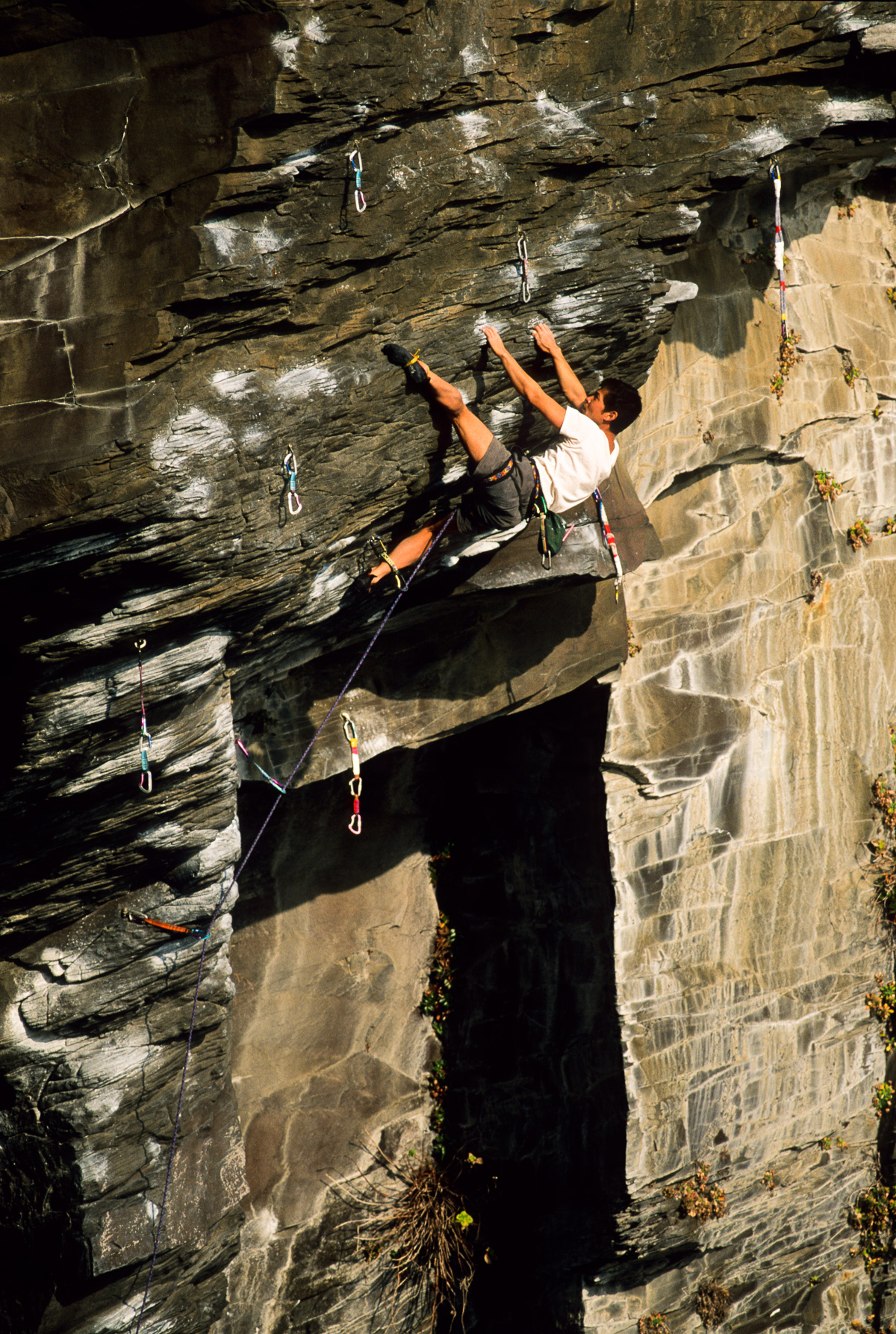
17 May Big in Japan… A Rock Climber’s Perspective…
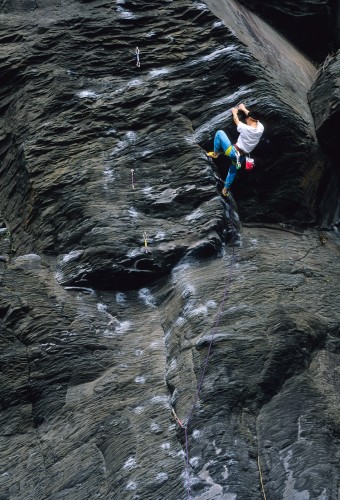
One can’t help but notice the spectacular grey-black volcanic andesite cliffs of Jogasaki are peppered with white chalk marks. Look closer, and you’ll see – pressed against these fractured faces and splayed over the boulders below – hordes of Japanese climbers decked out in flashy clothing and climbing gear. Right beside them, the waves of the Pacific Ocean thunder as they have for centuries against giant boulders on the rocky shore.
When I was assigned to an English-teaching post at Tenryu-shi, a small town of 25,000 people in Shizuoka Prefecture, I discovered I would be living near Jogasaki, one of Japan’s premier climbing areas. Not having known if I would even be able to climb in Japan, this was great news.
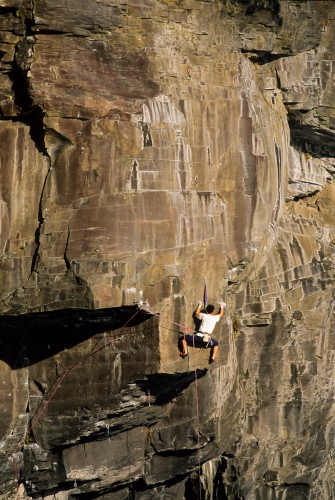
Before I left the States, a friend showed me a famous picture of Stephan Glowacz climbing the classic route Circus Right (5.12c/d). As a climber and photographer, I was ecstatic at the prospect of weekend trips to this surreal place I had seen in the photo.
One Japanese morning soon after that, my new friend Shigeto and I made the three hour drive down to the Izu Peninsula to see Jogasaki for ourselves. The town itself, renowned for its beauty and hot springs, is delightful, with quaint guest houses and shops lining a labyrinth of narrow streets. We soon realized our aimless wandering had gotten us lost. A quick stop for takoyaki (tasty dough-balls stuffed with octopus) gave us the energy to ask person after person for directions to the climbing – a location seemingly unknown to everyone. A few bushwacks and wrong turns and we soon found the Jogasaki coastline. The sight and sound of the ocean crashing against the grey, jagged and endless cliffs was mesmerizing. We abseiled down a tangled web of old fixed lines to the base of the cliffs. Walking through a boulder field in the shadow of the towering rock face, we entered the fantasy world of Seaside Sunset Wall.
Jogasaki’s routes have it all – cracks, slabs, overhangs, roofs all abound. The bubbly, volcanic andesite rock seems in perpetual motion, like something out of a Hunter S. Thompson acid trip. Of the many crags, the most popular is the Seaside Sunset Wall. Overhanging at an average of 115 degrees, this 100m long amphitheater houses 44 routes most 30m in length with grades range from 5.10 to 5.13. The climbing can be a little bold here; often the first bolt is 6m from the start of the route. A well placed cam will do wonders for your mental health in these situations.
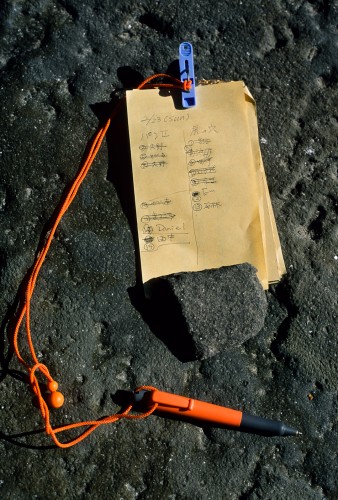
Because most Japanese work six days a week and due to its close proximity to Tokyo, the crags are packed on weekends – especially Sundays. Â Queues for the more popular routes can be so long you’ll often find a waiting list ready for you to sign at the base of the climb. On the classic Pumping Iron II (5.12b), I had to wait 1 1/2 hours before I got my chance. But it was worth the wait. It lived up to its reputation as one of the best routes at Jogasaki.
Even waiting around to climb can be as good as the actual climbing. The views from the cliff base are spectacular – the peak of Ooshima, one of Japan’s larger islands, looms out of the ocean 35 km to the east. Sea birds nest high up on the cliffs while climbers stretch out in the sun on myriad comfortably sea-sculpted boulders.
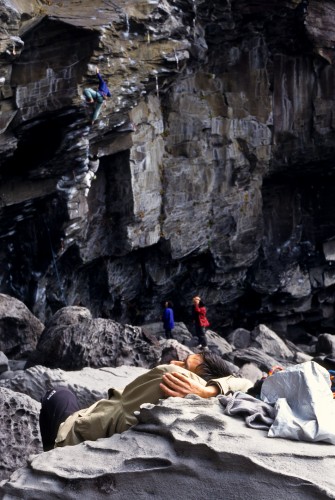
Rest time is occupied by munching on the many delicious and unusual foods Japan has to offer. One of my personal favorites, natto (fermented soy beans), is a great energy snack. Mixed with soy and Japanese mustard, it has a rather unpleasant color and consistency (looks like snot… for lack of a better word…). But it tastes great, has loads of protein and zero fat; ideal climber’s food.
The rare weekday climber will find Jogasaki empty. But there are advantages to climbing with the locals. Japanese climbers are extremely welcoming to foreigners and I have made many friends there. They are happy to go out of their way to translate the guidebooks, belay and, of course, help learn Japanese. When I first visited Jogasaki, everyone was very curious about my climbing skills. “What’s your hardest climb?” was a common question. Several years earlier, I climbed easy 5.13, but that was hardly indicative of my present fitness or ability there at Jogasaki. Nevertheless, whenever I climbed I drew a small crowd. Although I rarely impress anyone back home in Salt Lake City with my reaching prowess, in Jogasaki, every long reach elicited a flurry of comment from the onlookers below.
A climbing trip to Jogasaki offers a great chance to see some of the best parts of Japan: Tokyo, Mt. Fuji and the hot springs of Izu Peninsula. On Friday nights, the 3 hour trip from my flat seemed quite daunting, but the warmth of my Japanese friends and the walls of Jogasaki kept me coming back time and again.
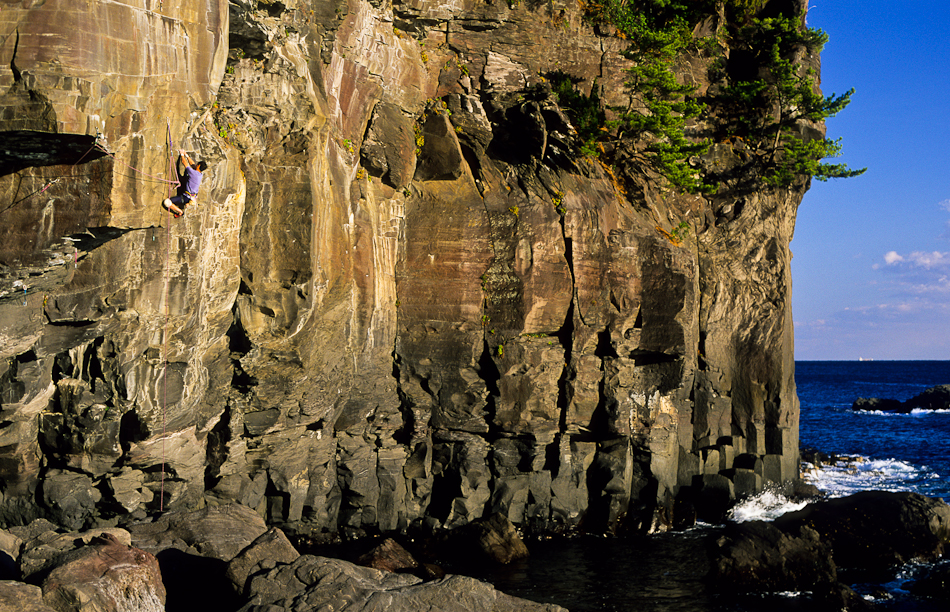



Kristin Miles
Posted at 23:59h, 02 JanuaryHey Dan, I knew you in Japan. I lived next to your town, in Hamakita. I’d love to see more of your photos from Japan, where is the best place to go to see them? I am especially impressed by your rock-climbing ones, I never got to do that there!
What camera did you use?
Regards,
Kristin (was Evans)
Eman
Posted at 21:28h, 20 MayNice. If you ever get a chance, go climb in Okinawa. Some excellent route with great locations for photography too.
Eman